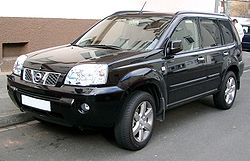The only thing that remained unchanged from the previous 300ZX is the 3.0-liter displacement, now with dual overhead camshafts and producing a rated 222 hp (166 kW) and 198 lb·ft (268 N·m) in naturally aspirated form. The big news for enthusiasts, however, was the turbo variant, now upgraded with twin Garrett turbochargers and dual intercoolers. This was good for 300 hp (224 kW) along with 283 lb·ft (384 N·m) of torque.[7] Performance varied from 0-60 times of 5.0-6.0 seconds depending on the source, and it had a governed top speed of 155 mph (249 km/h).
Upon its release, the new 300ZX became an instant hit, winning Motor Trend's "Import Car of the Year" in 1990 as well as "One of the Top Ten Performance Cars". Automobile Magazine honors the 300ZX/300ZX Turbo as its "Design of the Year" and adds it to their "All Stars" list. Road & Track names the 300ZX Turbo "One of the Ten Best Cars in the World", and Car and Driver adds it to their 10Best for the seven years in which it was in production in America. American Z-car sales reach the one million sales mark in the 1990 model year, making it the all-time best selling sports car.[8]
One of the first few cars completely designed with CAD software, it featured a whole host of technological advancements. On top-of-the-line twin turbo models, four-wheel steering was available under the name Super HICAS (High Capacity Actively Controlled Steering). The twin turbochargers, intercoolers, and requisite plumbing left for a cramped engine bay; however, everything fit perfectly with merely the slightest of bulges. The VG30DE(TT) engine also featured dual overhead camshafts and variable valve timing.
Like previous generations Nissan offered a 2+2 model with the Z32. In 1993, a convertible version was introduced for the first time in the Z-car's history, as a response to aftermarket conversions. All 300ZXs now featured T-tops as standard, yet there were some rare hardtops (known as "slicktops" to enthusiasts) produced as well.
The 300ZX was doomed to the same fate of many Japanese sports cars at the time. The mid-'90s trend toward SUVs and away from sports cars was influential in ending production in 1996 at over 80,000 units sold. However, the biggest killer of the 300ZX was its inflated price; at its release it was priced at a little over $30,000, but in its final year this price had increased to over $50,000. This left many people questioning its value, and despite a final Commemorative Edition of the final 300 units shipped to America (complete with decals and certificates of authenticity), the Z-car was on hiatus. In Japan, however, the 300ZX lived on for a few more years with a facelift including new rear turn signal len and chrome housing headlight.
Here is the footage of the last Nissan Z-car being built for the United States market in 1996. [9]








